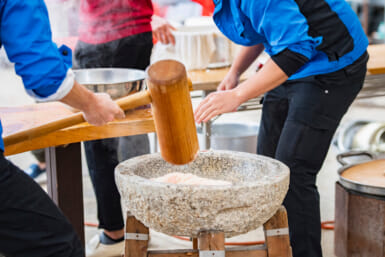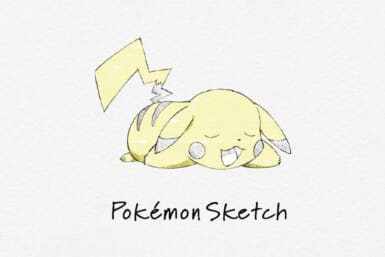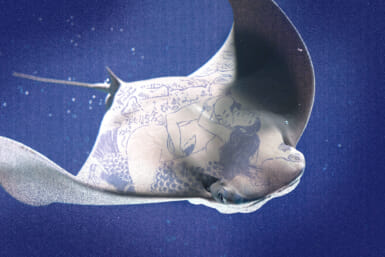The five men seated two meters apart in the conference hall at Mori Art Museum are a veritable who’s who of Japan’s contemporary art world. At the far end, Takashi Murakami, the pop artist who made his fame in America with collaborations with Louis Vuitton and Virgil Abloh, leans over to inspect the walls of the plastic enclosure separating him – and protecting him – from Lee Ufan.
This murderers’ row of artists – which also includes Tatsuo Miyajima, Yoshitomo Nara and Hiroshi Sugimoto – came together to announce the belated launch of the exhibition STARS: Six Contemporary Artists from Japan to the World. Missing from the press conference was the sixth artist, Yayoi Kusama, the exhibition’s only female representative.
“These artists came before me and broke through in the Western art world. What they have accumulated I have been able to build upon,” said Murakami during the press conference, noting that he is the youngest artist on exhibit. “I had the easy route because of what they did before me.”
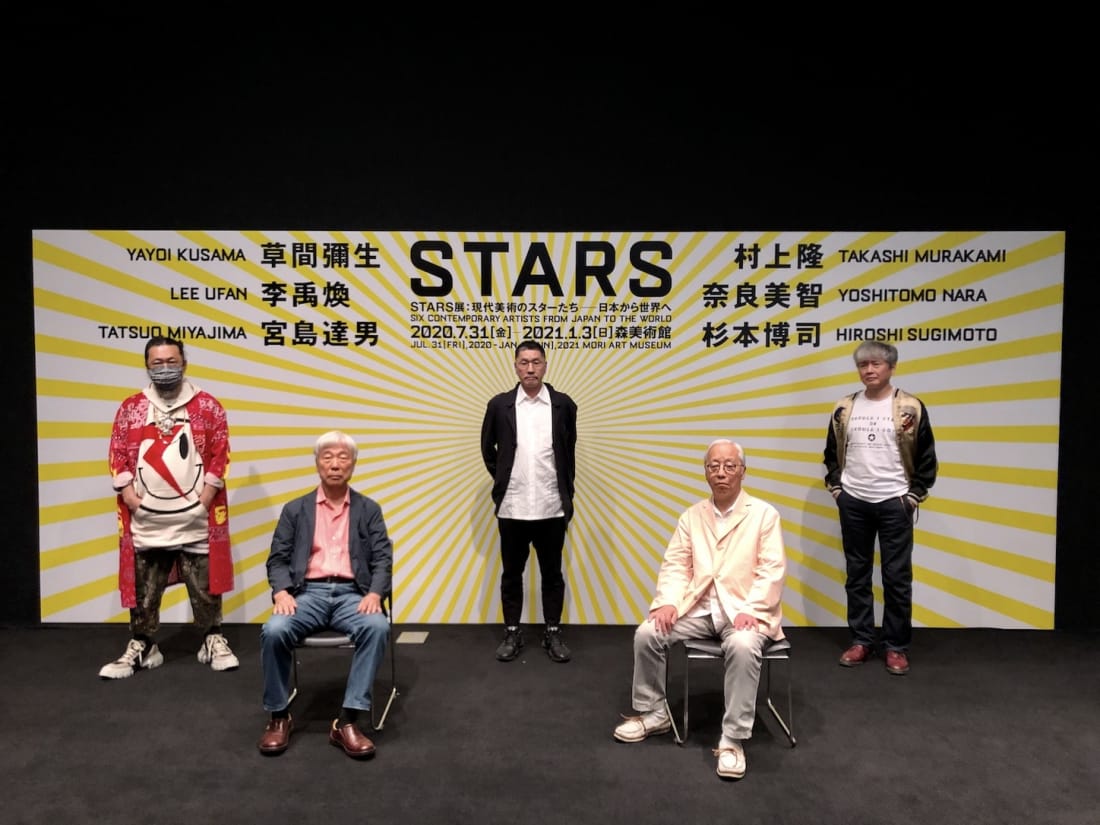
(l–r) Takashi Murakami, Lee Ufan, Tatsuo Miyajima, Hiroshi Sugimoto, Yoshitomo Nara
The exhibition was slated to open on April 23 – at the heart of Japan’s state of emergency declared to prevent the spread of new coronavirus infections. The state of emergency for Tokyo ended at the end of May, and Tokyo Metropolitan Government encouraged museums to recommence operations from the beginning of June to provide cultural enrichment to residents self-isolated at home.
Mori Art Museum Director Mami Kataoka, who took over the position in January following the retirement of Fumio Nanjo, noted the museum has been closed since the end of February. Before reopening, the museum implemented various countermeasures against the new coronavirus – including mandatory masks and temperature checks upon entry for visitors. Admission requires online advance booking for a designated time slot.
“Because of Covid-19 the world has changed,” said Kataoka during her opening remarks. “At this moment in history, the existence of art has been questioned. This unprecedented exhibition will shed light upon this fundamental question, and will shed light upon the very existence of art.”
STARS presents works that represent milestones in each artist’s career – from when they enjoyed their first bit of fame up to recent works – and even works never seen before. TW enjoyed a sneak preview of the exhibition, and this is what we saw.
Takashi Murakami: ‘I strove for a message directed towards the Japanese people’
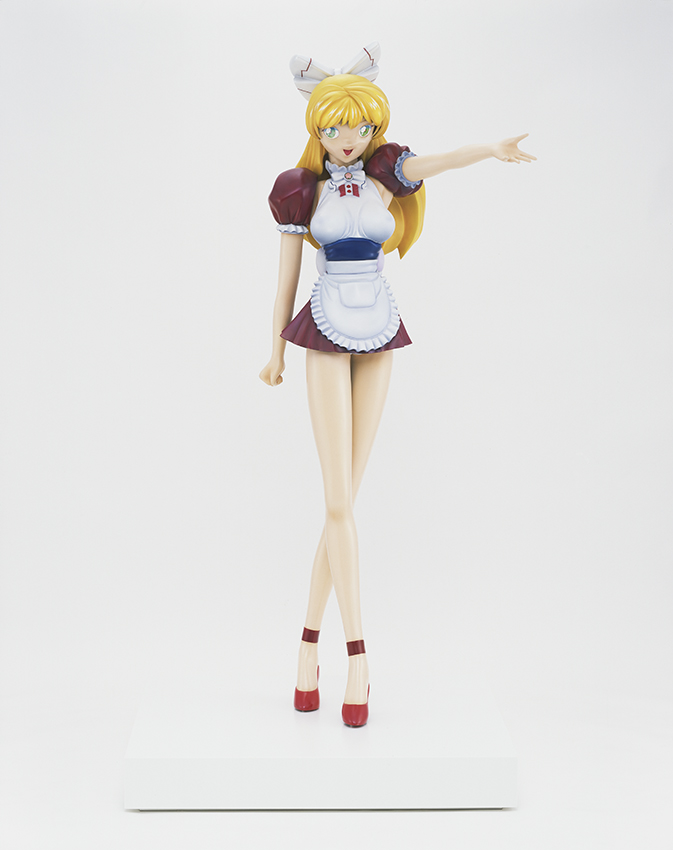
Takashi Murakami, Miss Ko² (Project Ko²), 1997, Oil paint, acrylic, fiberglass, iron, 181 x 61 x 102.5 cm
Welcoming visitors to the exhibition – and to the entrance of Murakami’s sensory feast – is the first version of the life-size sculpture “Miss Ko² (Project Ko²)” (1997). Murakami’s world of superflat insists that manga comics, commercial artwork, nihonga (traditional Japanese painting) – all styles of art really – hold equal value. Miss Ko and the ostentatious statues “Hiropon” (1997) and “The Lonesome Cowboy” (1998) – also on display – are hyper-sexualized figures that blur – or conjoin – the lines between fetishism, commercialism and high art.
Originally a student of nihonga, Murakami went to New York in the early ‘90s to study art, and it was during this time he developed his superflat philosophy, making the decision he says to leave Japanese audiences behind, and create Japanese art reflecting the otaku culture of manga and anime within a Western context.
“I was criticized, but this is a symbol of Japan,” says Murakami.
The Tokyo native’s section of the exhibit also includes two massive acrylic paintings approximately 20 meters in length that cover parallel walls. One wall is engulfed in Murakami’s ubiquitous trademark flowers, which have appeared on everything from skateboard decks to Uniqlo T-shirts. Perhaps coming full circle in his career, the other wall is covered by an anthropomorphized Mount Fuji smiling broadly over a field of sakura – a piece called “Cherry Blossoms Fujiyama JAPAN” (2020).
“This picture of Mount Fuji behind me was made for Japanese sensibilities,” says Murakami while holding court at his exhibition following the press conference. “This time, I strove for a message directed towards the Japanese people, or people who come to Japan.”
Lee Ufan: ‘I followed my own philosophy’
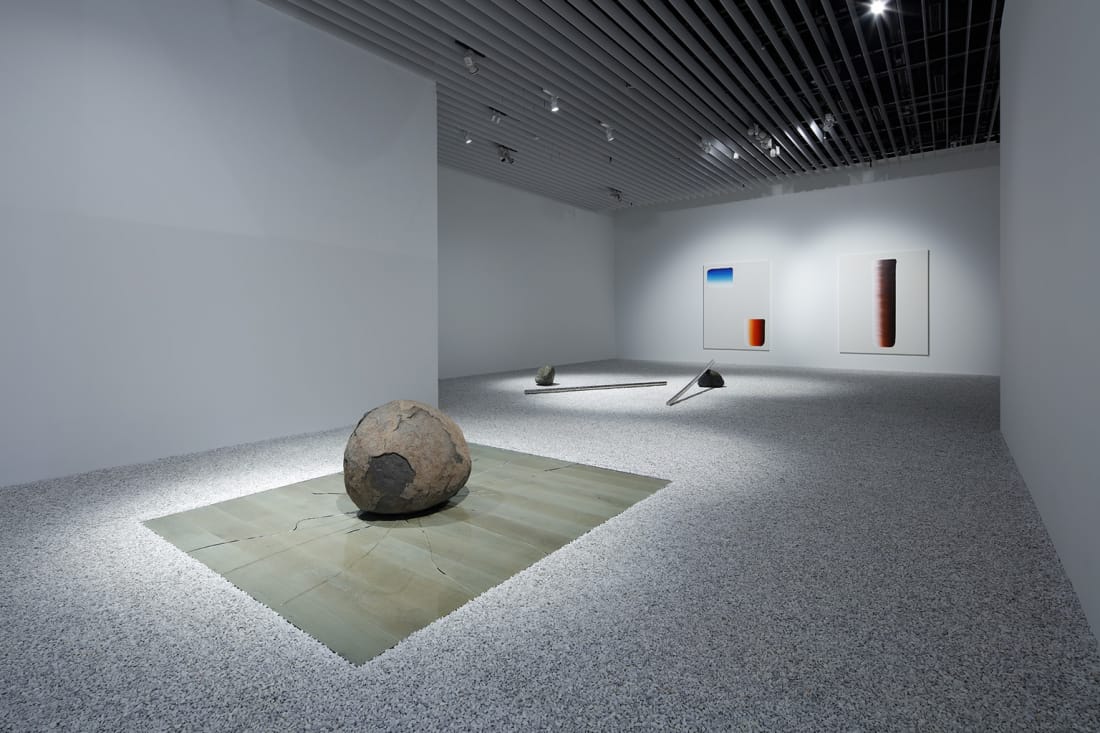
Lee Ufan, Installation view: STARS: Six Contemporary Artists from Japan to the World, Mori Art Museum, Tokyo, 2020 | Photo: Takayama Kozo, Photo courtesy: Mori Art Museum, Tokyo
Leaving behind Murakami’s carnival of color and overinflated sex organs brings you to the installation of Lee Ufan – a serene installation of sculpture and minimalist paintings all connected by a rock garden upon which visitors are welcome to walk. Born in South Gyeongsang, South Korea in 1936, Lee studied painting at the College of Fine Arts at Seoul National University before moving to Japan in 1956 to study philosophy at Nihon University, while also practicing traditional nihonga painting.
Lee is a noted critic of modernity and the expressive abstraction that was gaining popularity in the 1960s. He is a leading theorist and practitioner of Mono-ha (School of Things). The sculptural movement rejects Western ideas of production and manufacturing, presenting objects and materials in their natural state. “I was criticized in Europe – that’s just Japanese,” said Lee. “And I followed my own philosophy.”
After participating in the Biennale de Paris in 1971, Lee has since held a large-scale retrospective at the Guggenheim Museum in 2011, a solo exhibition at the 7th Palace of Versailles in 2014 and a solo exhibition at the Centre Pompidou-Metz, France, in 2019. The Lee Ufan Museum, designed by architect Tadao Ando, opened on the island of Naoshima in 2010.
On display at Mori Art Museum is one of Ufan’s earliest works, “Relatum” (1969/2020). The sculpture presents a red stone atop an iron plate serving as the medium to form a reciprocal relationship between the viewer, the materials and the site – the State of Things. Also on display are two new acrylic on canvas paintings commissioned for the STARS exhibition. Titled “Dialogue” (2020), the two paintings placed side-by-side are representative of Ufan’s abstract painting influenced by his years studying nihonga. The repetitive gestural marks notate the perpetual passage of time.
Yayoi Kusama: ‘The distinct style is seen in her latest painting series”
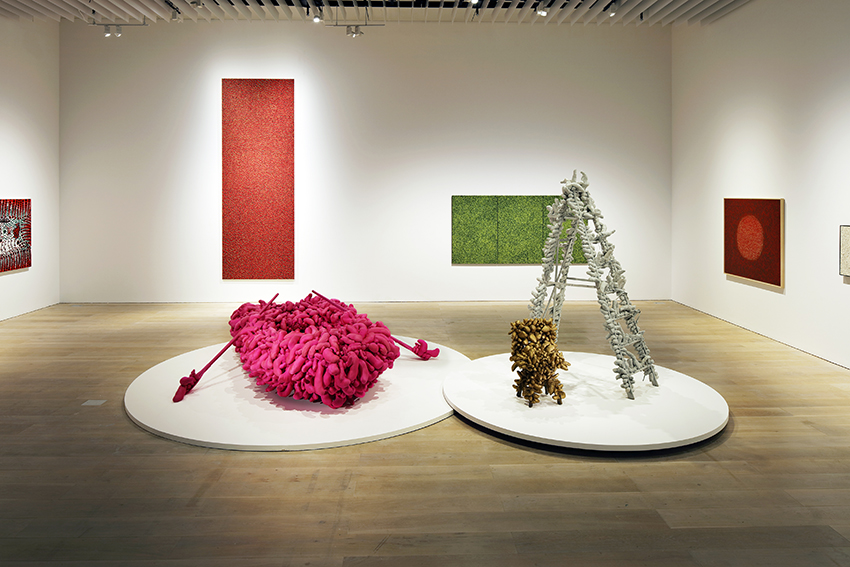
Yayoi Kusama, Installation view: STARS: Six Contemporary Artists from Japan to the World, Mori Art Museum, Tokyo, 2020 | Photo: Takayama Kozo, Photo courtesy: Mori Art Museum, Tokyo
Smaller in scale when compared to Murakami and Lee’s grand installments, Yayoi Kusama’s exhibition is the third stop along the STARS tour. While Kusama’s display isn’t as cohesive as Murakami’s or Lee’s, the works on display summarize Kusama’s career, which arcs more than five decades.
Selected as one of TIME’s 100 Most Influential People of 2016, Kusama was considered a leader of New York City’s avant-garde art movement of the late ‘60s, and gained notoriety for organizing controversial happenings at places like Central Park and the Brooklyn Bridge as protests against the Vietnam War.
On display at Mori Art Museum are soft sculptures from this early period in New York. One such piece, “Traveling Life” (1964), is a white ladder covered in cilia-like protuberances, with dilapidated high heel shoes clinging to various rungs. Kusama returned to Japan in 1973 and continued to be active, with her works, often featuring familiar motifs such as pumpkins and flowers, earning popular acclaim since the 1990s.
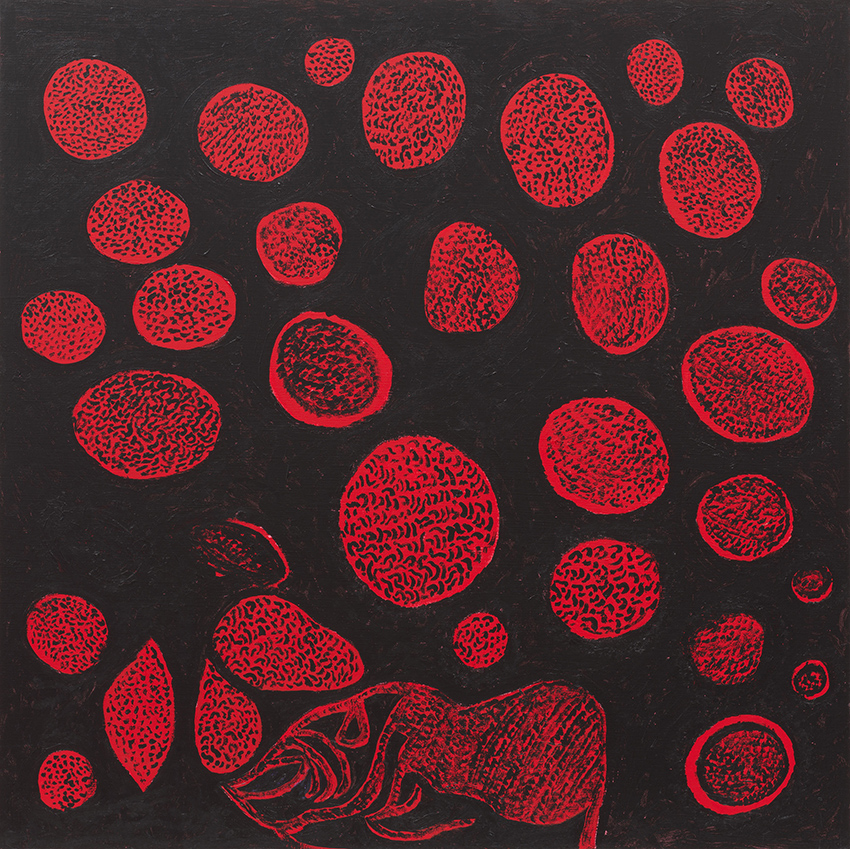
Yayoi Kusama, SPLENDOR OF NUMEROUS LOVES, 2019, Acrylic on canvas , 100.3 x 100.3 cm, Collection: T Party Ltd.
In 1993 she represented Japan at the 45th Venice Biennale with her soft sculpture “Pink Boat” – the centerpiece of her STARS exhibition. In 1998 she held a solo exhibition co-organized by the Los Angeles County Museum of Art and the Museum of Modern Art, New York. The 2018 documentary of the artist’s life, Kusama: Infinity, introduced her work, and life, to an even wider audience.
Influenced by hallucinations and obsessions that have persisted since youth, Kusama’s work is identified by repetitious patterns. The distinct style is seen in her latest painting series on display at STARS in the abstract acrylic painting, “SPLENDOR OF NUMEROUS LOVES” (2019).
Tatsuo Miyajima: ‘Ultimately the world is within you’
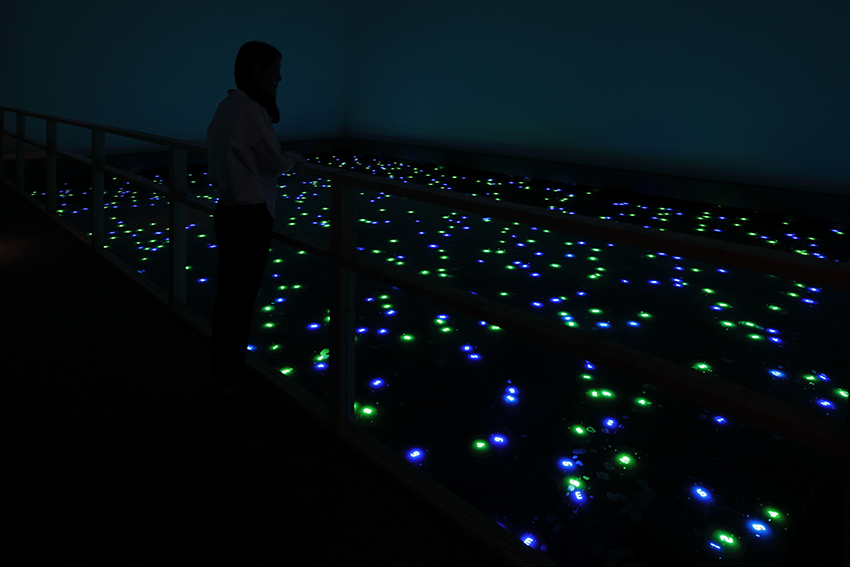
Tatsuo Miyajima, Sea of Time – TOHOKU Project (2020, Tokyo), 2020, Waterproof LED, electric wire, IC, water, Installation view: STARS: Six Contemporary Artists from Japan to the World, Mori Art Museum, Tokyo, 2020 | Photo: Takayama Kozo, Photo courtesy: Mori Art Museum, Tokyo
Entering Tatsuo Miyajima’s “Sea of Time – TOHOKU Project” (2020, Tokyo), visitors are greeted by the gentle sound of trickling water. Miyajima began the Sea of Time series of installations in 1988 with an exhibition at the 43rd Venice Biennale. The sculptures and installations use digital counters displaying changing numbers, based on the concepts “it keeps changing,” “it connects with everything” and “it continues forever.”
The project took on new earnest following the 2011 Great East Japan Earthquake, and Miyajima has continuously worked on the “Sea of Time – TOHOKU Project” since 2017. The installation at STARS is the largest in the series, and it serves as a prayer for the victims of the tragedy.
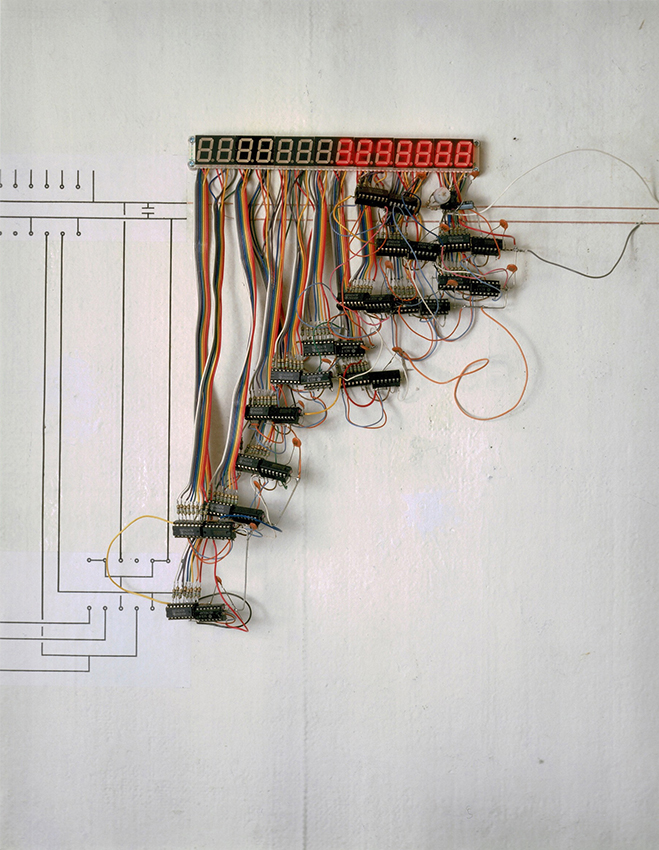
Tatsuo Miyajima, Clock for 300 Thousand Years, 1987, Light-emitting diode, IC, electric wire, and others, 32 x 21 x 4.5 cm | Photo: Hirose Tadashi
Miyajima said 3,000 residents of Tohoku, young and old, installed the 3,000 green and blue LED lights that count from one to nine, each at a different pace. The installation represents the Buddhism concept of 3,000 realms in a single moment of life and the message that life contains infinite potential.
“Ultimately the world is within you. As William Blake said, you can see the world in a single grain of sand,” said Miyajima. “Three thousand people set up this installation. Their memories are gathered together at this point in time…. We have seen trauma and scars, I would like to resuscitate these scars and from here we can move onwards. How do we need to live our life? How do we need to live our life during the Covid pandemic? Art allows us to reflect on the past and move into the future.”
Yoshitomo Nara: ‘I wanted to share what is in my mind’
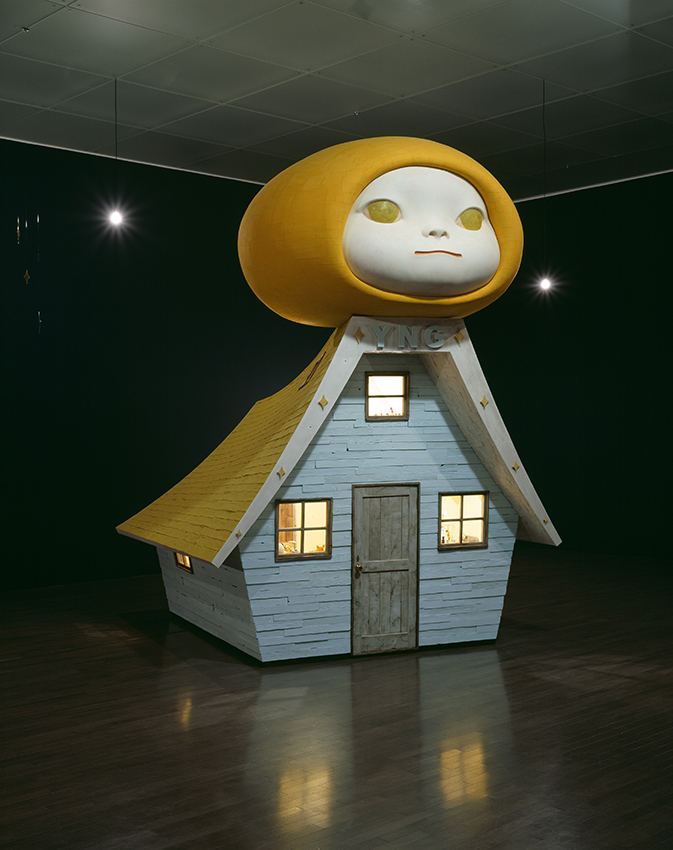
Yoshitomo Nara. Voyage of the Moon (Resting Moon) / Voyage of the Moon, 2006, Mixed media, 476 x 354 x 495 cm, Cooperation provided by graf, Collection: 21st Century Museum of Contemporary Art, Kanazawa | Photo: Nakamichi Atsushi / Nacása & Partners
“It is like peeking into the brain of Nara-san,” says Kataoka, of Yoshitomo Nara’s contribution to the STARS exhibition. Upon entering Nara’s area visitors are greeted by a wall of CD albums from the ‘70s through the ‘90s, including offerings from such bands as Rancid, Bikini Kill, Social Distortion and The Pixies as well as Lou Reed, The Rolling Stones and David Bowie – all the music Nara listens to while making his unique blend of introverted pop art. Another display shows the albums for which Nara designed the cover, including CDs for Shonen Knife and R.E.M.
The main attraction is truly like peeking into the mind of Nara. The installation “Voyage of the Moon (Resting Moon) / Voyage of the Moon” (2006) is a life-size, fairy-tale style blue hut, with a giant doll-like head, hooded in yellow, perched atop the peak. Peeking through the door, the song “Hello Delilah” by the Plain White T’s quietly plays from a small speaker. The softly lit interior is cluttered with pull-toys, a sock monkey and other nostalgic memorabilia from youth. There are also Nara’s kawaii sketches, and a crucifix.
“I wanted to share what is in my mind,” says Nara. “Books, music they can directly influence me, but all art pieces are multi-layered. Everything exists underneath.”
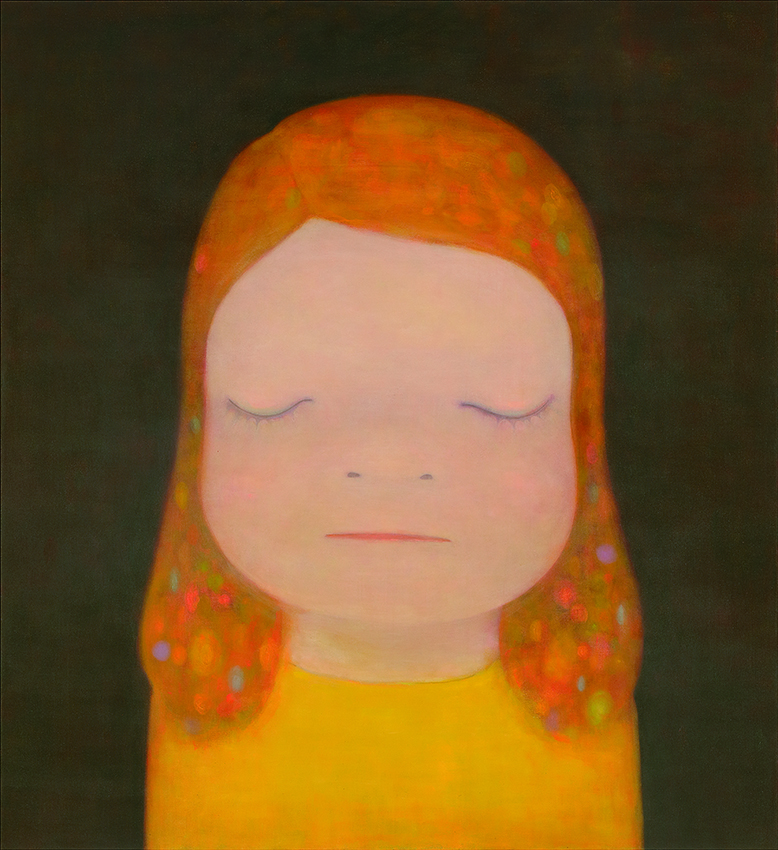
Yoshitomo Nara, Miss Moonlight, 2020, Acrylic on canvas, 220 x 195 cm
The serene doll-head perched atop the hut is representative of the moon, which Nara says like him, is still – quiet. While sunlight is powerful and bright, allowing people to see, at the same time it hides the stars.
The Hirosaki, Aomori Prefecture native spent the latter part of the 20th century making art in Germany before returning to Japan in 2000. Since then he held major solo exhibitions in the States and throughout Japan. His popularity is growing in Southeast Asia and this year Nara holds a large-scale solo exhibition at the Los Angeles County Museum of Art.
A new acrylic painting on display at Mori Art Museum titled “Miss Moonlight” (2020) – a cherubic girl with eyes closed, innocent and melancholic at once – is representative of why Nara’s work is still being discovered and why his acclaim is on the rise.
Hiroshi Sugimoto: ‘Time is unyielding’
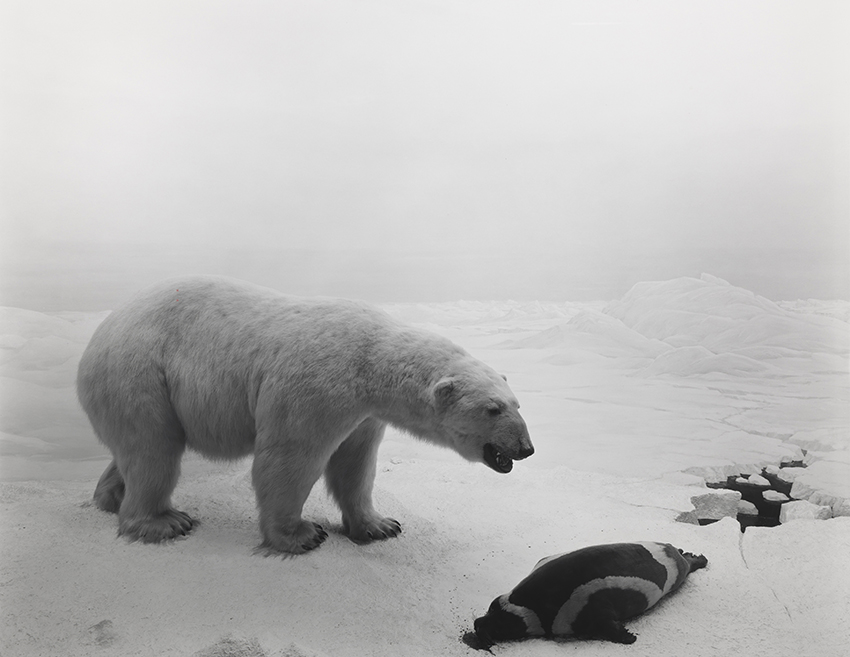
Hiroshi Sugimoto, Polar Bear, 1976, Gelatin silver print, 42.3 x 54.6 cm
While Nara’s activity has found life in the 21st century (he is active on Instagram with more than 200,000 followers), Hiroshi Sugimoto won’t be found on social media. Instead, he will be found at the Odawara Art Foundation Enoura Observatory in Kanagawa, which opened in 2017. Twenty years in the making, this massive land art designed by Sugimoto includes art galleries, a teahouse, outdoor theaters and stunning views of Sagami Bay. At the STARS exhibit, Sugimoto debuts his film, “The Garden of Time” (2020), which captures the seasons at the Enoura Observatory in stunning detail.
“This is my first video,” says Sugimoto. “It is only 33 minutes so I don’t know if you can call it a film. There is no sound, no music, subtitles, some poems.”
Towards the end of the video, which entails sweeping shots of seascapes as seen from the observatory, Sugimoto himself appears above, looking down at the camera as if looking into well. The subtitles read, “Goodbye garden of time. Come again, garden of time.”
A poem then reads, “Time is unyielding. Only in this garden is it allowed for time to move in both ways.”
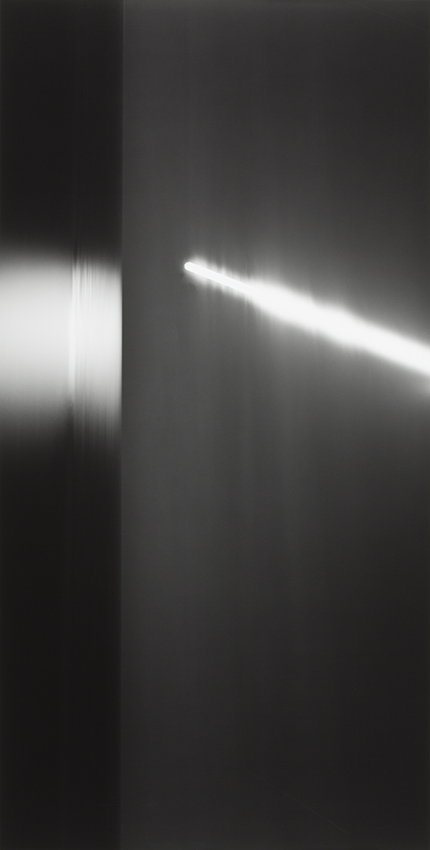
Hiroshi Sugimoto, Revolution 008, Caribbean Sea, Yucatan, 1990, Gelatin silver print, 238.8 x 119.4 cm
While the observatory represents Sugimoto’s epic, grandiose worldview and sense of history, in 1970 when he was a 22-year-old young art school graduate he moved to Los Angeles with no money in his pocket. Even though stricken with culture shock, he was determined to study photography – and become an art photographer.
After settling in New York in 1974, his artwork gained attention and the Diorama series, photos that shuttle between reality and fiction, drew attention. In 1977, the piece “Polar Bear” (1976) was acquired by the Metropolitan Museum of Art. The striking photograph, which is on display at the STARS exhibition, is a photo of a diorama at the American Museum of Natural History, that through the use of long exposure times and a large view camera, become lifelike, and captivating.
Sugimoto’s work has been exhibited around the world and has been obtained for numerous collections. In 2005, his solo exhibition at the Mori Art Museum, End of Time, traveled to three cities in the US. He now delves into architecture, traditional Japanese art and classical performing arts. On display at Mori Art Museum is also part of his meteorite collection.
“Meteorites did not burn up when they fell from space,” says Sugimoto. “They remind me of stars that did not burn up.”
STARS: Six Contemporary Artists from Japan to the World is on exhibit at Mori Art Museum through January 3, 2021
Feature image: Takashi Murakami, Cherry Blossoms Fujiyama JAPAN, 2020, Acrylic on canvas, 500 x 2,125 cm


